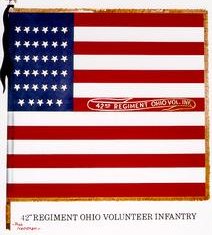| Educated at Oberlin College, Sheldon was the principal recruiter of the 42nd Ohio. Following Middle Creek, he and his men saw action with Sherman’s Corps at Chickasaw Bayou, Port Gibson, and Thompson’s Hill. Wounded during the latter engagement, he spent the rest of the war building forts and repairing levees. Born in Winchester, New York in 1828, Lionel Allen Sheldon came from Revolutionary stock, both grandfathers having served in the Continental Army. In the late 1830s his family moved to Elyria, Ohio, where his father established a farm. When Sheldon turned eighteen, he enrolled at Oberlin College, supporting himself by teaching school during the winter term. Establishing a law practice in Elyria in 1853, he soon became one of the town’s most successful lawyers. In 1861 Governor Dennison offered him a colonel’s commission and asked him to organize a regiment for the Federal Service. Sheldon responded by stumping the county and raising five companies in six days. In the Fall of 1861 Sheldon reported to Camp Chase in Columbus, Ohio, where he was mustered in as Lt. Colonel of the 42nd Ohio, the regiment then being organized by Garfield. When the 42nd Ohio and its sister regiment, the 40th Ohio, boarded steamboats and left Cincinnati for Catlettsburg in December, 1861, Garfield commanded the brigade and Sheldon commanded the regiment. Following their service in the Big Sandy Valley, Sheldon and his men were transferred to Memphis and attached to Sherman’s command. They saw action during Sherman’s attack on Chickasaw Bayou in December, 1862, winning the ground over which Blair’s brigade subsequently made its assault. Under General Grant they participated in the attack on Port Gibson, Mississippi, and saw action during the assault on Thompson’s Hill. Wounded in the hand by a musket ball, Sheldon stayed at his post, leading two gallant charges on the enemy position. During the engagements at Raymond, Jackson, and Black River Bridge, Sheldon followed his regiment in an ambulance but recuperated in time to participate in the siege of Vicksburg. Transferred with his regiment to Plaquemine, Louisiana and given command of a brigade, Sheldon spent the rest of the war building forts and repairing levees. Following Appomattox he established a law practice in New Orleans and became one of its leading lawyers. He served in the U.S. Congress from 1869 to 1875, and from 1881 to 1885 he served as Governor of New Mexico Territory. He died in Pasadena, California in 1917 and is buried in the Mountain View Cemetery at Altadena. |
| Colonel Lionel A. Sheldon of the 42nd Ohio |
 |
| Colonel George W. Monroe Colonel Ezekiel F. Clay Colonel Don A. Pardee Colonel Hiram Hawkins Colonel John S. Williams Colonel Alfred C. Moore Colonel George W. Gallup Dr. Stephen M. Ferguson |
| Photo courtesy of Roger D. Hunt and Jack R. Brown, Brevet Brigadier Generals in Blue (Olde Soldier Books, Inc., 1990) |
| Regimental Colors of the 42nd Ohio. Courtesy of the Ohio Historical Society. |
 |